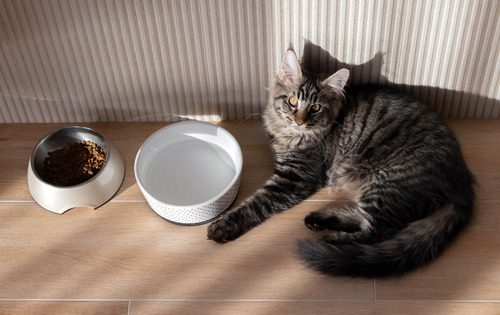7 Signs of Cat Dehydration to Watch For
Cats are known for their independent nature and ability to hide discomfort, making it challenging for pet owners to detect health issues. One such issue is dehydration, which can lead to serious health problems if not addressed promptly. Understanding the signs of cat dehydration can help you ensure your feline friend stays healthy and hydrated. In this blog, we’ll explore the common signs of dehydration in cats and what you can do to help prevent it.

Understanding Cat Dehydration
Dehydration in cats occurs when there is an excessive loss of fluids from their body, affecting their normal bodily functions. Water is crucial for your cat’s overall health, aiding in digestion, circulation, and temperature regulation. Cats can become dehydrated for various reasons, including insufficient water intake, illness, or excessive heat.
What Causes Dehydration in Cats?
- Insufficient Water Intake: Cats are notorious for not drinking enough water. Their low thirst drive can be attributed to their evolutionary history as desert animals.
- Illness: Conditions such as kidney disease, diabetes, and hyperthyroidism can cause increased fluid loss and lead to dehydration.
- Heat Exposure: During hot weather, cats can lose fluids through panting and sweating through their paws.
- Vomiting and Diarrhea: These symptoms can cause a rapid loss of fluids, leading to dehydration if not managed promptly.
Signs of Dehydration in Cats
Recognizing the signs of dehydration in your cat can help you take timely action. Here are seven signs to watch for:
1. Loss of Skin Elasticity
One of the most common and easily recognizable signs of dehydration in cats is a loss of skin elasticity. You can test this by gently pinching the skin on the back of your cat’s neck and releasing it. In a well-hydrated cat, the skin should quickly snap back into place. If the skin takes longer to return to its normal position, your cat may be dehydrated.
2. Sunken Eyes
Sunken eyes are another indicator of dehydration in cats. When a cat is dehydrated, the eyes may appear dull and less vibrant. This occurs because the body is conserving water, causing the tissues around the eyes to shrink.
3. Dry Mouth and Gums
A healthy cat’s mouth and gums should be moist. If your cat’s mouth and gums are dry or sticky, it could be a sign of dehydration. You can check this by gently lifting your cat’s lip and feeling the gums. Dry or tacky gums indicate a lack of sufficient moisture.
4. Lethargy and Weakness
Dehydrated cats often exhibit lethargy and weakness. They may be less active, sleep more than usual, and show little interest in playing or interacting. Dehydration reduces the volume of blood and oxygen that reaches the muscles, leading to fatigue.
5. Loss of Appetite
A dehydrated cat may lose interest in food. If you notice that your cat is eating less or refusing to eat altogether, dehydration could be a contributing factor. The lack of water affects the digestive system, making your cat feel less inclined to eat.
6. Increased Heart Rate
Dehydration can cause an increase in your cat’s heart rate. You can check your cat’s pulse by placing your hand on their chest, just behind the left front leg. A normal heart rate for a cat is between 160 to 220 beats per minute. If your cat’s heart rate is elevated, it could be due to dehydration.
7. Reduced Urine Output
A well-hydrated cat will urinate regularly. If you notice that your cat is producing less urine or that the urine is darker in color, it could be a sign of dehydration. Monitor your cat’s litter box habits to ensure they are urinating normally.
Cat Dehydration Prevention
Preventing dehydration in cats involves ensuring they have access to fresh water at all times and encouraging them to drink more. Here are some tips to help keep your cat hydrated:
- Provide Fresh Water: Ensure your cat has access to clean, fresh water at all times. Change the water daily and clean the bowl to prevent bacteria build-up. Some cats prefer running water, so consider investing in a cat water fountain.
- Wet Food Diet: Incorporating wet food into your cat’s diet can help increase their water intake. Wet food has a higher moisture content compared to dry kibble, which can aid in hydration.
- Add Water to Dry Food: If your cat primarily eats dry food, you can add a small amount of water to the kibble to increase moisture content. This can make the food more palatable and help with hydration.
- Encourage Drinking: Encourage your cat to drink more by placing multiple water bowls around your home. Some cats are more likely to drink if water is available in different locations.
- Monitor Health Conditions: If your cat has a health condition that predisposes them to dehydration, such as kidney disease or diabetes, work closely with your veterinarian to manage the condition and prevent dehydration.
When to Seek Veterinary Care
If you suspect your cat is dehydrated, it’s essential to seek veterinary care promptly. Dehydration can be a sign of an underlying health issue that requires medical attention. Your veterinarian can perform a thorough examination and recommend appropriate treatments.
Emergency Care & Treatment
At Pets Furst Urgent Care in Langhorne, PA, our team is dedicated to providing urgent care for your pets, including treatment for dehydration. If you notice any signs of dehydration in your cat, call us at (215) 755-1000. Our experienced veterinarians will ensure your cat receives the care they need to recover and stay healthy.
Keeping Your Cat Hydrated and Healthy
Cat dehydration is a serious issue that requires prompt attention. By recognizing the signs and taking preventive measures, you can help keep your feline friend hydrated and healthy. Remember to provide fresh water, incorporate wet food into their diet, and monitor their health closely. If you notice any signs of dehydration, contact Pets Furst Urgent Care at (215) 755-1000 for expert veterinary care.
recent posts
- « Previous
- 1
- 2
About Us
At Pets Furst Urgent Care, your time is important to us. That’s why we’re here: To provide the highest level of pet urgent care possible on a walk-in basis. That means you can stop in at any time during our office hours to see a knowledgeable veterinarian.

